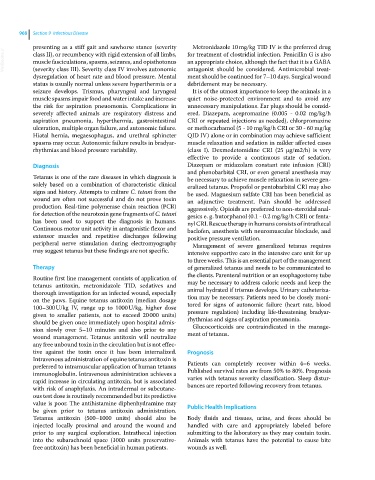Page 1030 - Clinical Small Animal Internal Medicine
P. 1030
968 Section 9 Infectious Disease
presenting as a stiff gait and sawhorse stance (severity Metronidazole 10 mg/kg TID IV is the preferred drug
VetBooks.ir class II), or recumbency with rigid extension of all limbs, for treatment of clostridial infection. Penicillin G is also
an appropriate choice, although the fact that it is a GABA
muscle fasciculations, spasms, seizures, and opisthotonus
(severity class III). Severity class IV involves autonomic
ment should be continued for 7–10 days. Surgical wound
dysregulation of heart rate and blood pressure. Mental antagonist should be considered. Antimicrobial treat-
status is usually normal unless severe hyperthermia or a debridement may be necessary.
seizure develops. Trismus, pharyngeal and laryngeal It is of the utmost importance to keep the animals in a
muscle spasms impair food and water intake and increase quiet noise‐protected environment and to avoid any
the risk for aspiration pneuomonia. Complications in unnecessary manipulations. Ear plugs should be consid-
severely affected animals are respiratory distress and ered. Diazepam, acepromazine (0.005 - 0.02 mg/kg/h
aspiration pneumonia, hyperthermia, gastrointestinal CRI or repeated injections as needed), chlorpromazine
ulceration, multiple organ failure, and autonomic failure. or methocarbamol (5 - 10 mg/kg/h CRI or 30 - 60 mg/kg
Hiatal hernia, megaesophagus, and urethral sphincter QID IV) alone or in combination may achieve sufficient
spasms may occur. Autonomic failure results in bradyar- muscle relaxation and sedation in milder affected cases
rhythmias and blood pressure variability. (class I). Dexmedetomidine CRI (25 µg/m2/h) is very
effective to provide a continuous state of sedation.
Diagnosis Diazepam or midazolam constant rate infusion (CRI)
and phenobarbital CRI, or even general anesthesia may
Tetanus is one of the rare diseases in which diagnosis is be necessary to achieve muscle relaxation in severe gen-
solely based on a combination of characteristic clinical eralized tetanus. Propofol or pentobarbital CRI may also
signs and history. Attempts to culture C. tetani from the be used. Magnesium sulfate CRI has been beneficial as
wound are often not successful and do not prove toxin an adjunctive treatment. Pain should be addressed
production. Real‐time polymerase chain reaction (PCR) aggressively. Opioids are preferred to non-steroidal anal-
for detection of the neurotoxin gene fragments of C. tetani gesics e. g. butorphanol (0.1 - 0.2 mg/kg/h CRI) or fenta-
has been used to support the diagnosis in humans. nyl CRI. Rescue therapy in humans consists of intrathecal
Continuous motor unit activity in antagonistic flexor and baclofen, anesthesia with neuromuscular blockade, and
extensor muscles and repetitive discharges following positive pressure ventilation.
peripheral nerve stimulation during electromyography Management of severe generalized tetanus requires
may suggest tetanus but these findings are not specific. intensive supportive care in the intensive care unit for up
to three weeks. This is an essential part of the management
Therapy of generalized tetanus and needs to be communicated to
Routine first line management consists of application of the clients. Parenteral nutrition or an esophagostomy tube
tetanus antitoxin, metronidazole TID, sedatives and may be necessary to address caloric needs and keep the
thorough investigation for an infected wound, especially animal hydrated if trismus develops. Urinary catheteriza-
on the paws. Equine tetanus antitoxin (median dosage tion may be necessary. Patients need to be closely moni-
100–300 U/kg IV, range up to 1000 U/kg, higher dose tored for signs of autonomic failure (heart rate, blood
given to smaller patients, not to exceed 20 000 units) pressure regulation) including life‐threatening bradyar-
should be given once immediately upon hospital admis- rhythmias and signs of aspiration pneumonia.
sion slowly over 5–10 minutes and also prior to any Glucocorticoids are contraindicated in the manage-
wound management. Tetanus antitoxin will neutralize ment of tetanus.
any free unbound toxin in the circulation but is not effec-
tive against the toxin once it has been internalized. Prognosis
Intravenous administration of equine tetanus antitoxin is
preferred to intramuscular application of human tetanus Patients can completely recover within 4–6 weeks.
immunoglobulin. Intravenous administration achieves a Published survival rates are from 50% to 80%. Prognosis
rapid increase in circulating antitoxin, but is associated varies with tetanus severity classification. Sleep distur-
with risk of anaphylaxis. An intradermal or subcutane- bances are reported following recovery from tetanus.
ous test dose is routinely recommended but its predictive
value is poor. The antihistamine diphenhydramine may Public Health Implications
be given prior to tetanus antitoxin administration.
Tetanus antitoxin (500–1000 units) should also be Body fluids and tissues, urine, and feces should be
injected locally proximal and around the wound and handled with care and appropriately labeled before
prior to any surgical exploration. Intrathecal injection submitting to the laboratory as they may contain toxin.
into the subarachnoid space (1000 units preservative‐ Animals with tetanus have the potential to cause bite
free antitoxin) has been beneficial in human patients. wounds as well.

